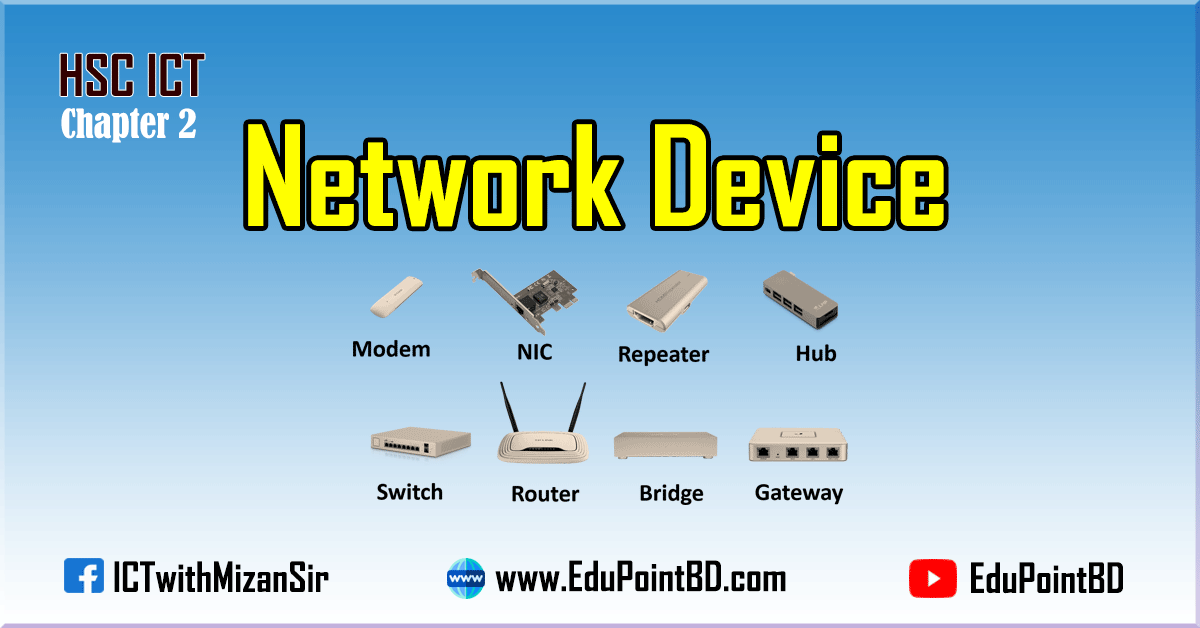
At the end of this lesson-
1. You will be able to describe different network devices.
2. You will be able to describe the uses of different network devices.
3. You will be able to explain the advantages and disadvantages of different network devices.
Go for Bangla Version
Network devices:
Hardware devices that are used to connect computers, printers, fax machines and other electronic devices to a network are called network devices. These devices transfer data in a fast, secure and correct way over same or different networks. Network devices may be inter-network or intra-network.
Different Network Devices:
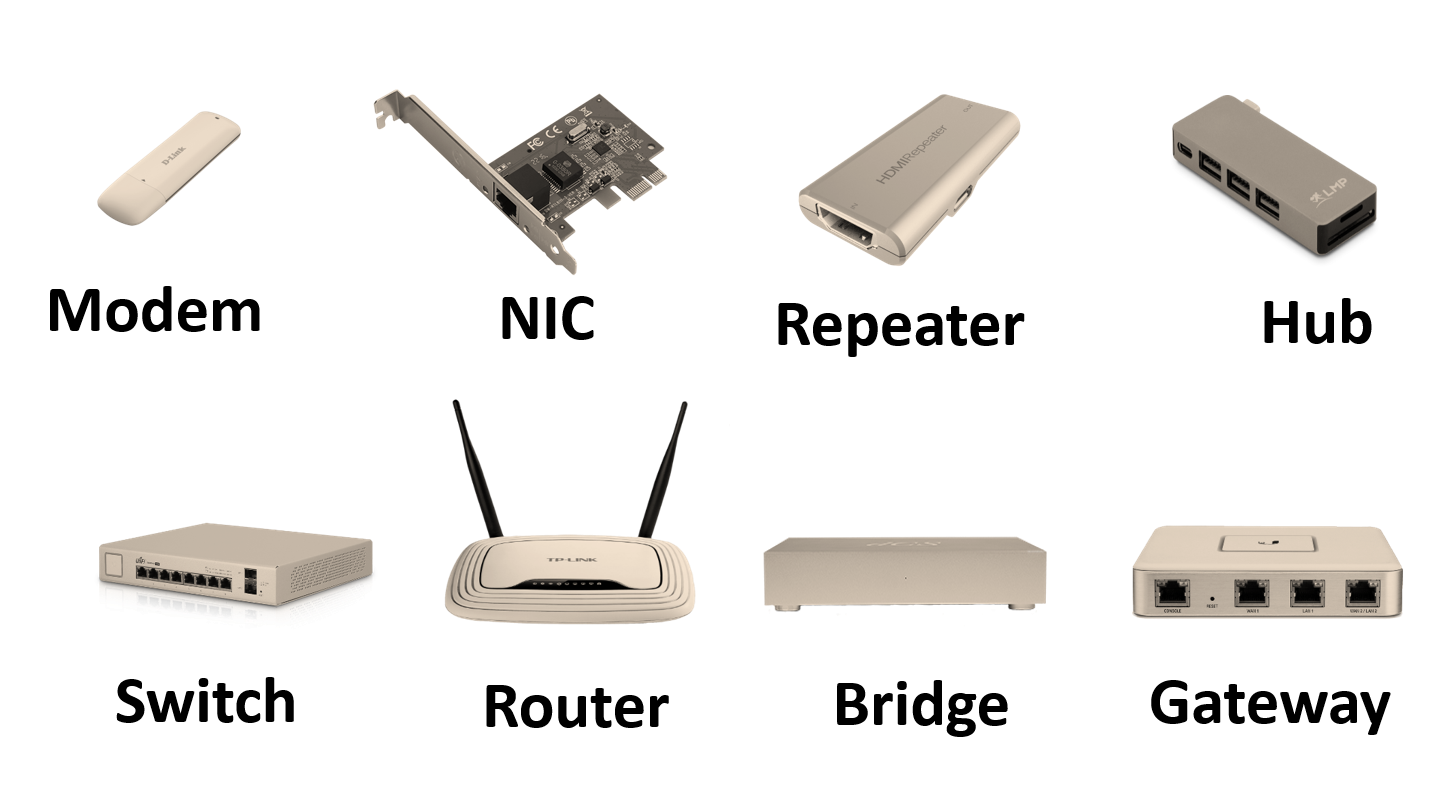
Modem:
Modem is a device that enables a computer to send or receive data over telephone or cable lines. Modem is a combination of two devices − modulator and demodulator. The modulator converts digital data into analog data when the data is being sent by the computer. The demodulator converts analog data signals into digital data when it is being received by the computer.

The data stored on the computer is digital whereas a telephone line or cable wire can transmit only analog data.The main function of the modem is to convert digital signal into analog and analog into digital signal.
NIC:
NIC stands for Network Interface Card. This is also known as network adapter card, Ethernet Card and LAN card. NIC allows a networking device to communicate with the other networking device. In modern computer systems, it is an internal hardware component. LAN cards are mounted in different shaped slots on the motherboard. Most NIC computers are built-in. LAN cards have a unique code of 48 bits. This unique code is called the MAC (Media Access Control) address. This MAC address is stored in the card’s ROM. The NIC has RJ45 socket where network cable is physically plugged in.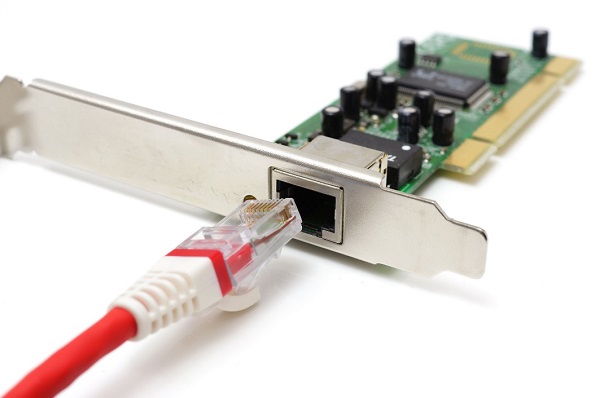
NIC converts the data packets between two different data transmission technologies. A PC uses parallel data transmission technology to transmit the data between its internal parts while the media that provides connectivity between different PCs uses serial data transmission technology.
Types of NICs: There are two types of NICs.
Media Specific: LAN card are used according to the media type. Different types of the NICs are used to connect the different types of media. To connect a specific media type, we must have to use a NIC which is particularly made for that type of media.
Network Design Specific: A specific network design needs a specific LAN card. For example FDDI, Token Ring and Ethernet have their own distinctive type of NIC cards. They cannot use other types of NIC cards.
Repeater:

A repeater operates at the physical layer. Its job is to regenerate the signal over the same network before the signal becomes too weak or corrupted so as to extend the length to which the signal can be transmitted over the same network. An important point to be noted about repeaters is that they do not amplify the signal. When the signal becomes weak, they copy the signal bit by bit and regenerate it at the original strength. It is a 2 port device.
Hub:
A hub is basically a multiport repeater. Hub is a centralized device that connects multiple devices in a single LAN network. Hubs cannot filter data, so data packets are sent to all connected devices. When Hub receives the data signals from a connected device on any of its port, except that port, it forwards those signals to all other connected devices from the remaining ports.
In other words, collision domain of all hosts connected through Hub remains one. Also, they do not have intelligence to find out best path for data packets which leads to inefficiencies and wastage.
Usually, Hub has one or more uplink ports that are used to connect it with another Hub.

Types of Hub
Active Hub:
These are the hubs which have their own power supply and can clean, boost and relay the signal along with the network. It serves both as a repeater as well as wiring center. These are used to extend the maximum distance between nodes.
Passive Hub :
It forwards data signals in the same format in which it receives them. It does not change the data signal in any manner. These are the hubs which collect wiring from nodes and power supply from active hub. These hubs relay signals onto the network without cleaning and boosting them and can’t be used to extend the distance between nodes.
Switch:
Switch is a network device that connects other devices to Ethernet networks through twisted pair cables. It uses packet switching technique to receive, store and forward data packets on the network. The switch maintains a list of network addresses of all the devices connected to it.
On receiving a packet, it checks the destination address and transmits the packet to the correct port. Before forwarding, the packets are checked for collision and other network errors. The data is transmitted in full duplex mode

Data transmission speed in switches can be double that of other network devices like hubs used for networking. This is because switch shares its maximum speed with all the devices connected to it. This helps in maintaining network speed even during high traffic. In fact, higher data speeds are achieved on networks through use of multiple switches.
Bridge:
Bridge is used to divide a large network into smaller segments. Basic functions of the Bridge are the following: –
- Breaking a large network into smaller segments.
- Connecting different media types. Such as connects UTP with the fiber optic.
- Connecting different network architectures. Such as connects Ethernet with the Token ring.

A Bridge can connect two different types of media or network architecture, but it cannot connect two different types of network layer protocol such as TCP/IP or IPX. Bridge requires the same network layer protocol in all segments.
There are three types of Bridge:-
Local Bridge: – This Bridge connects two LAN segments directly. In Ethernet Implementation, it is known as the Transparent Bridge. In Token Ring network, it is called the Source-Routed Bridge.
Remote Bridge: This Bridge connects with another Bridge over the WAN link.
Wireless Bridge: This Bridge connects with another Bridge without using wires. It uses radio signals for the connectivity.
Router:
A router is a device like a switch that routes data packets based on their IP addresses. Router is mainly a Network Layer device. Routers normally connect LANs and WANs together if networks support the same set of protocols and have a dynamically updating routing table based on which they make decisions on routing the data packets. Router also strengthens the signals before transmitting them. That is why it is also called repeater.
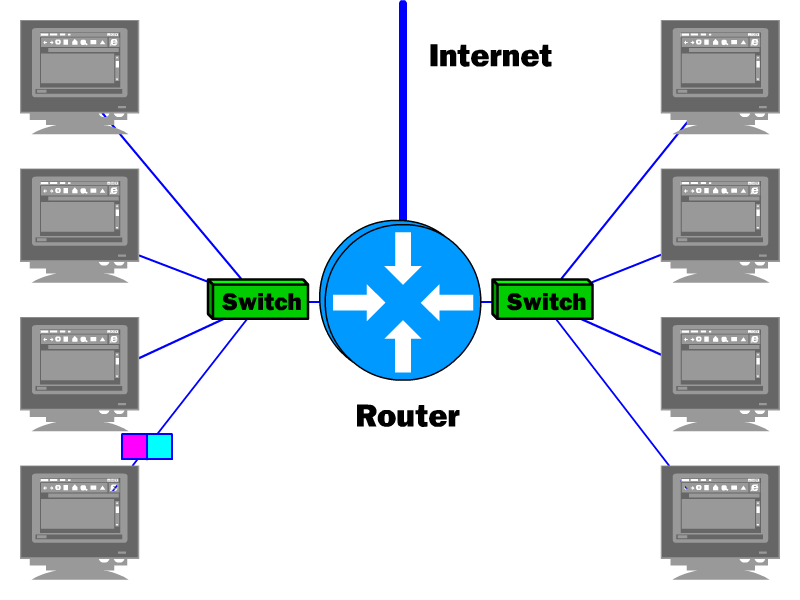
Routing Table
A router reads its routing table to decide the best available route the packet can take to reach its destination quickly and accurately.
Basically routers are used:
- To connect different network segments.
- To connect different network protocols such as IP and IPX.
- To connect several smaller networks into a large network (known as the Internetwork)
- To break a large network into smaller networks (Known as the Subnets. Usually created to improve the performance or manageability.)
- To connect two different media types such as UTP and Fiber optical.
- To connect two different network architectures such as Token Ring and Ethernet.
- To connect LAN network with Telco company’ office (Known as the DTE device).
- To access DSL services (known as the DSL Router).
Brouter:
It is also known as bridging router is a device which combines features of both bridge and router. It can work either at data link layer or at network layer. Working as router, it is capable of routing packets across networks and working as bridge, it is capable of filtering local area network traffic.
Gateways:
Gateway is a network device used to connect two or more networks having different protocols. A gateway usually is a computer with multiple NICs connected to different networks. A gateway can also be configured completely using software. As networks connect to a different network through gateways, these gateways are usually hosts or end points of the network.

Gateway uses packet switching technique to transmit data from one network to another. In this way it is similar to a router, the only difference being router can transmit data only over networks that use same protocols.
Gateways are also called protocol converters and can operate at any network layer. Gateways are generally more complex than switch or router.
Network devices in a network:
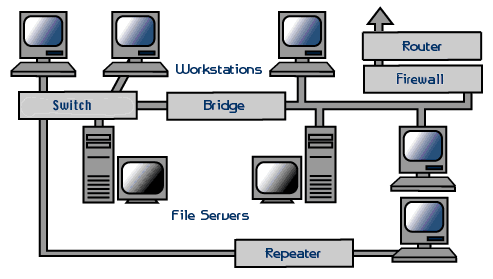
Lesson Evaluation-
Knowledge Based Questions:
a) What is modem?
a) What is NIC?
a) What is Hub/Switch/Router?
a) What is Gateway/Bridge?
a) What is repeater?
a) What is protocol?
Comprehension Based Questions:
b) “Only modulation or demodulation can not be effective method” -explain.
b) “Modem play an important role in data communication” -Explain.
b) Which one is more convenient between hub and switch? explain.
b) Explain the way of strengthening week signal in data transmission.
b) In which case gateway is more effective? explain.
b) Explain the reason for using MAC address.
Creative Questions:
Read the following stem and answer the question:

c) Describe the device of marked P in fig-B.
Multiple Choice Questions:
1. Which network device facilitates protocol translation?
a) NIC b) Bridge c) Repeater d) Gateway
2. By which device can the signal be transmitted from the transmitter computer to the specific recipient computer?
a) Hub b) Switch c) Repeater d) Bridge
3. What is called the function of converting analog signal of a modem to digital signal?
a) Modulation b) Demodulation c) Encoding d) Decoding
4. Data filtering is possible for which of the following devices?
a) Hub b) Switch c) Router d) Repeater
5. Which device converts analog signal to digital signal?
a) Modem b) Switch c) Router d) Repeater
6. Modem-
i. Converts digital signals to analog signals
ii. Acts as sender and receiver
iii. Acts as a medium of data communication
Which one is correct?
a) i & ii b) i & iii c) ii & iii d) i, ii & iii
7. The device used to connect a computer to a network is called a-
a) Modem b) NIC c) Router d) Hub
Read the following stem and answer question 8:
Mr. Sabbir brought 4 computers from different rooms of his office to a network through the hub. A few days later he bought a laptop and used cable to receive broadband internet service. He wanted to avoid the use of cable as well as internet service on all computers.
8. Which device is more suitable for him?
a) Switch b) Hub c) Router d) Repeater
9. How many bits is the MAC address?
a) 6 b) 12 c) 36 d) 48
10. How many bytes of MAC address?
a) 6 b) 12 c) 36 d) 48
11. Which of the following devices strengthens or amplifies a weak signal?
a) Hub b) Switch c) Router d) Repeater
12. Which of the following devices broadcasts the signal?
a) Hub b) Switch c) Router d) Repeater
13. Which of the following is a LAN device?
a) Hub b) NIC c) Router d) Modem
14. Which device divides a large network into smaller segments?
a) Hub b) Bridge c) Router d) Modem
15. Which device uses the routing table?
a) Modem b) Switch c) Router d) Repeater
16. Which device connects multiple networks with different protocols?
a) Bridge b) Switch c) Router d) Gateway
17. Which device connects multiple networks with the same protocol at different distances?
a) Bridge b) Switch c) Router d) Gateway
Written by,
- Mizanur Rahman (Mizan)
- Lecturer in ICT, Shaheed Bir Uttam Lt. Anwar Girls’ College , Dhaka Cantonment
- Founder & Author at www.edupointbd.com
- Software Engineer at mands IT
- Former Lecturer in ICT, Cambrian College, Dhaka
- Contact: 01724351470
